- Time
- (Edited)
- Post link
ATMachine said:
Here's Moebius's take on Sorsha.
I really like these designs, the one on the left in particular. It's a shame neither made it into the final film.
So I'm working on putting together an essay that captures my thoughts on Willow and its relationship to SW, as well as Lucas's various influences while writing it. By no means all of it is relevant to a SW forum, but I'll excerpt some interesting bits.
---
Willow's species, the Nelwyns, were obviously modeled on the Hobbits from The Lord of the Rings. It appears that, early on in the writing of the film, Willow's best friend Meegosh was going to be a more important character. His role was probably reduced because he proved to be too obviously similar to Tolkien’s Sam Gamgee.
At one point during the writing of the original 1977 SW, Lucas considered having all the natives of Tatooine—including Luke Skywalker, Owen and Beru, and Ben Kenobi—be played by little people, with everyone else cast as an average-size human. The idea was to make Tatooine into a space-fantasy equivalent of the Shire in LOTR, but it never got very far.
---
As well, I mentioned in another thread that the idea of a "magic tree" guarding the entrance to the Force cave on Dagobah in ESB was almost reused in Willow.
Apparently in early outlines for Willow, there was a scene with a tree growing above the mouth of a cave where a fierce dragon lived. The tree itself would have been ordinary-looking on the outside, but with an inner core of solid gold (a reference to Kurosawa's The Hidden Fortress, where Princess Yuki's golden treasure is hidden inside sticks of firewood).
---
Also, as far as the prequels go, you can see a LOT of influence on their art direction stemming from the French artist Moebius's concept art for Willow. Those designs, in turn, were influenced by Lucas wanting to reuse ideas from the early drafts of the OT that never made it to the screen.
Observe:

This is Moebius's concept drawing of Madmartigan. Although he clearly resembles Robert E. Howard's Conan the Cimmerian, the hairstyle incorporates Lucas’s love of Asian costume. It’s long in the back, but with a shaved portion just above the forehead. This style blends the shaved pate of a Japanese samurai chonmage with the shaved fore-crown of Manchu-era Chinese men’s hairstyles.
The dark hair also boosts Madmartigan's resemblance to Toshiro Mifune, who was one of the two major influences (the other being Flash Gordon) on the appearance of protagonist Annikin Starkiller in the very first rough draft of The Star Wars.
Except for the shaved forehead, this hairstyle survived intact for the final film’s Madmartigan…
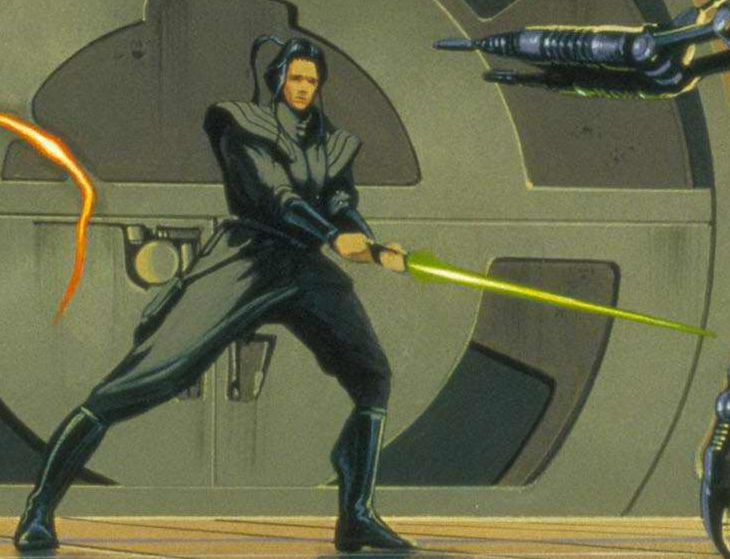
…and was actually recycled in early TPM concept art of Obi-Wan Kenobi.
Madmartigan's name is a combination of Tolkien's "Aragorn" and "Mad Max" from the eponymous film.
---
Here's Moebius's take on Sorsha.
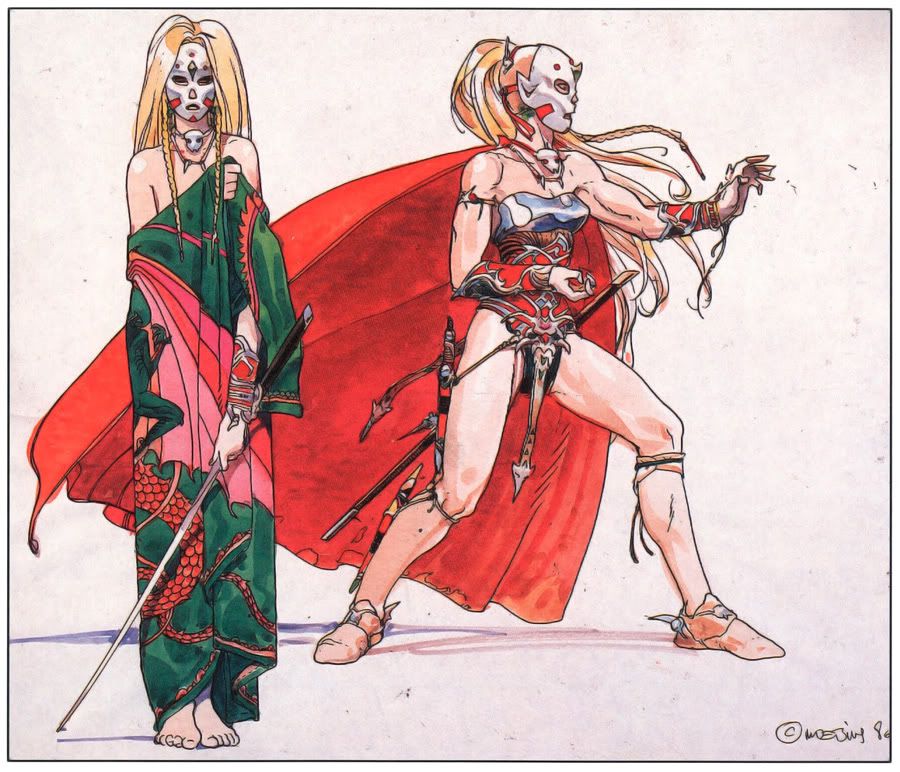
Note her blonde hair. At this early point in production, Sorsha was envisioned not as a human like in the final film, but rather as a half-Elf. The final film's fully human Sorsha has red hair, much like Princess Leia Aquilae in the rough draft of SW 1977.
The white mask Moebius gives Sorsha here, which combines geisha makeup with the horns of an oni, invites comparisons with another character from the rough draft of The Star Wars: Prince Valorum, a Sith knight who switches sides near the end of the script and joins the good guys. At the end of the story Valorum is one of the heroes seen sitting in honor by Queen Leia’s throne.
The character arc of Prince Valorum would later evolve into the redemption of Darth Vader/Anakin Skywalker. Darth Vader’s helmet, in turn, would find a descendant in Sorsha’s oni mask. However, like Valorum, Sorsha survives the film.
Even as late as the “third revision” script, Sorsha is described as having a face-concealing helmet. This idea would later be transferred to General Kael, a villain who is not redeemed.
I also suspect, given the origin of Madmartigan's name, that the white mask in this portrayal of Sorsha is inspired by the villain of Mad Max 2...

...who is known as "The Humongous." The half-Elf version of Sorsha would indeed be "humongous" standing next to her full-Elf kindred.
But that’s not all. The end of the rough draft of The Star Wars was clearly inspired by the ending of Kurosawa’s The Hidden Fortress, where Princess Yuki is revealed as the beautiful ruler of the Akizuki clan in exile. In this scene Yuki is shown wearing white geisha makeup, clearly visible despite the black-and-white cinematography.
So that idea passed down to Sorsha’s hybrid geisha/oni mask, and then finally…
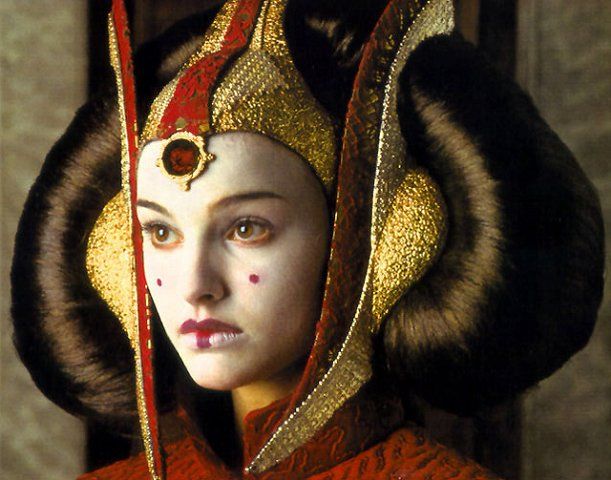
…to Queen Amidala in The Phantom Menace.
As well, Sorsha’s shaved-head-with-topknot hairstyle in the above concept drawing was reused in TPM…
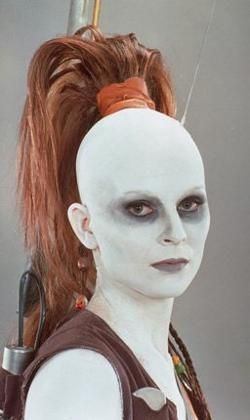
…for the briefly seen Aurra Sing, an extra in the Podrace scene.
---
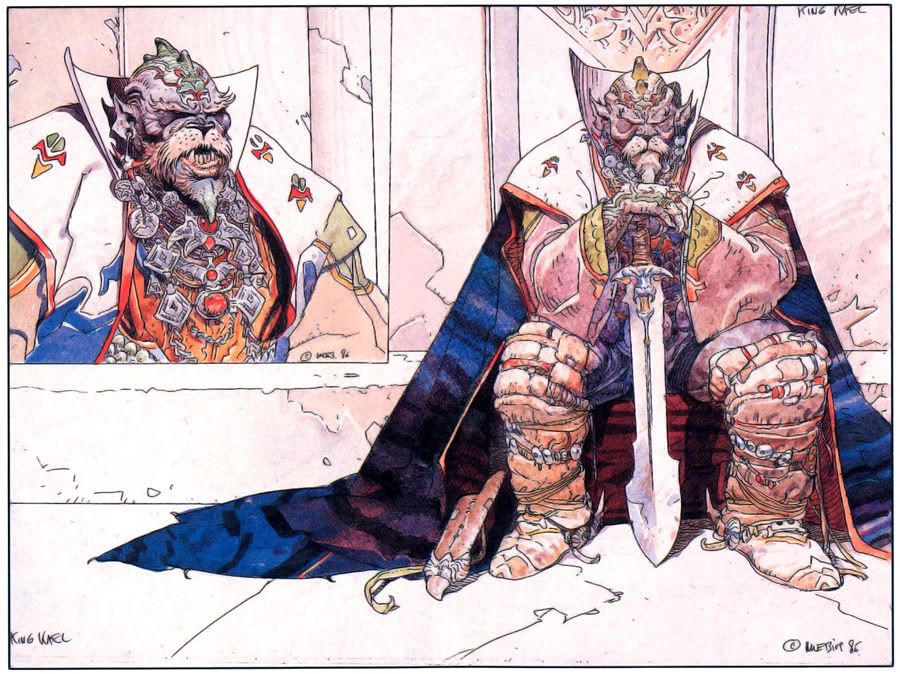
King (later General) Kael, the monstrous second-in-command of Bavmorda’s army. In Moebius’s drawings Kael is an inhuman creature, and he is still described as such in the third-revision script. However, in the final film he is merely human, though he wears a face-concealing helmet like that originally planned for Sorsha.
Note the forehead tattoo and horns that Moebius has given Kael here. These motifs would later recur...
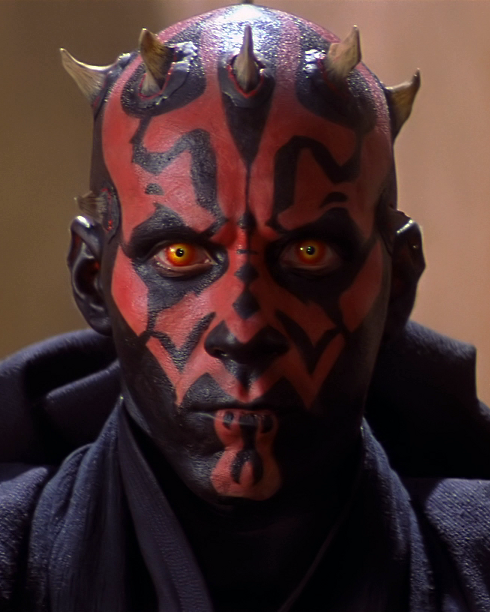
…in the character of Darth Maul, who like Kael is merely the henchman of a greater villain.
“That Darth Vader, man. Sure does love eating Jedi.”
Willow in prototype looks like it would have been a lot more interesting than the movie we ultimately got. I do recall a critic or two noting similarities to Tolkien at the time.
Is there anything to suggest Lucas might have wanted to adapt The Hobbit or LOTR, and couldn't get the rights, much like he was once thwarted in his desire to make a Flash Gordon film?
Where were you in '77?
I don't know if Lucas ever formally tried to get the rights. He was probably canny enough not to even attempt it by that point. Besides, Saul Zaentz had already picked up the rights to LOTR; while the Silmarillion rights have never been sold, and likely won't be until after Christopher Tolkien is dead.
Having said that, there are a LOT of things even in the earliest versions of Willow that were directly inspired by Tolkien's work. In fact, some scenes were originally more similar to prototypes in The Silmarillion than they ultimately turned out to be.
For instance, the journey to the Elven Otherworld of Tir Asleen (as it originally was) was done via water, like the journey to Valinor. And as with Valinor, it is normally impossible for mortals to reach Tir Asleen--in this case because a fearsome sea monster guards the way.
There was also a scene immediately before that, where Willow and Madmartigan find a ruined human castle. Willow uses magic to resurrect twelve knights inside who have been petrified by Bavmorda, and Madmartigan asks them to set out with him on the impossible journey to Tir Asleen.
Impressed by his courage, the knights decide to make him their new King, and join his quest. However, other humans hiding out in the castle from Bavmorda's troops decline to go, only to show up and save the day heroically, Han Solo-style, later in the film.
This scene has obvious parallels in the stories of the mortal heroes Tuor and Beren in The Silmarillion. Tuor finds a suit of armor in the abandoned Elven castle of Nevrast, which ends up leading him on a quest to find the hidden Elf city of Gondolin. And Beren pleads with the King of Nargothrond, Finrod Felagund, for help in stealing a priceless Silmaril from Morgoth's crown. Finrod and ten Elf warriors join Beren (for a total of twelve), but the other Elves refuse to go out of fear.
Plus Sorsha originally being a half-Elf is a clear reference to Arwen.
On the other hand, there are also some clear Narnia references. Sorsha is pretty clearly a female version of Shasta, the hero of The Horse and His Boy, who was kidnapped at birth and raised as a poor peasant in a foreign country. The plot of the novel concerns Shasta's journey home and his discovery that he is really a prince.
Bavmorda's petrification of the twelve knights also has echoes of the White Witch Jadis in The Lion, The Witch and the Wardrobe.
There's even a bit of Robert E. Howard thrown in. A couple of ferocious blue-painted warriors, originally known as Picts and later renamed Pohas in typical Lucas fashion, make a cameo appearance in early scripts. And General (originally King) Kael was obviously named after Howard's King Kull, literary precursor to Conan.
“That Darth Vader, man. Sure does love eating Jedi.”
There was a group of six petrified knights who are revived to aid the hero in the 1962 film The Magic Sword. (Although it appears they were willingly cast under a spell, as they were promised as a 21st birthday gift to the hero.) Seems to be an idea that gets around.
Where were you in '77?
ATMachine said:
Here's Moebius's take on Sorsha.
I really like these designs, the one on the left in particular. It's a shame neither made it into the final film.
I've thought of many of the more obvious points where there are similarities, but was not aware of such detail. Great thread!
Here is a rather long summary of how I believe the plot of Willow stood at the point when Moebius did his concept art:
Willow Ufgood, a diminutive Nelwyn, finds a human baby, Elora Danan, who is being pursued by the armies of the sorceress Bavmorda. To keep his village safe, Willow knows he must return the baby to the world of the humans. He sets out accompanied by his best friend Meegosh. The duo do not get far before they meet Mad Martigan (then so spelled), a great human swordsman who is currently in a position of dishonor. The idea of having Madmartigan imprisoned in a cage at a crossroads may already have existed.
At this point we are also introduced to Airk Thaughbaer, Mad Martigan’s old comrade-in-arms. Airk is riding with an army to confront the sorceress Bavmorda, who has just destroyed the great castle of Galladoorn, which belonged to Airk’s king.
After much debate, Willow and Meegosh free Mad Martigan, entrusting him with the baby, and begin to return home. However, they are kidnapped by trolls and imprisoned in their underground lair. The Nelwyns also see that the trolls have kidnapped Elora Danan.
Fortunately, the Nelwyns and Elora are rescued by two brownies, small water sprites who lead them to a waiting boat. The trolls pursue them in their own boats, and a dramatic river chase ensues.
At last the trolls lose the chase—possibly by being killed by sunlight when dawn breaks, or maybe via a flood of water summoned by the Brownie Elder, like that called up by Elrond to defeat the Black Riders in The Fellowship of the Ring.
The Nelwyns travel on to Brownie Island, where they are reunited with Mad Martigan. Here the Brownie Elder tells them that they must take Elora Danan to the benevolent sorceress Fin Raziel, who lives in a wasteland. She can lead them to the hidden Elf city of Tir Asleen, where Elora Danan will be safe.
The Brownie Elder gives three magic acorns to Willow, which will turn to stone whatever they are thrown at. In the third-revision script the fairy queen Cherlindrea, who replaced the Brownie Elder, gives them to Willow, but in the final film they are given to him by the Nelwyn village’s elder, the High Aldwin.
Mad Martigan and the Nelwyns set out on their journey with the child. Because the Brownies are water sprites, and they will be traveling overland, presumably they leave the Brownies behind. In the final film Meegosh would depart at this point, being replaced by two Brownies (who are no longer associated with water).
They stop briefly at an inn, where they are discovered by Bavmorda’s troops, led by Sorsha. Mad Martigan is struck by Sorsha’s beauty, but she demands he hand over the child. As in the finished film, a chase through the woods on horse-drawn carts and chariots ensues.
The heroes elude their pursuers, and finally reach the wasteland of Fin Raziel. Here there is nothing but barren sand and rock, except for one lone tree in the middle.
Mad Martigan recounts the legend that the tree in Fin Raziel’s dwelling place is made of solid gold. When they approach, Meegosh starts breaking off the branches of the tree, and discovers that while the exterior is covered in bark, the inner core is indeed golden. (I suspect that in this early version of the film, Meegosh was principally a comic-relief character. In the third-revision script, where the tree is still present but Meegosh is gone, Madmartigan takes over the role of the greedy branch-picker.)
Meanwhile, Willow notices a tree-dwelling creature nestled among the branches. It’s Fin Raziel! She explains that she was cursed by Bavmorda, and that they themselves are in dire danger. Meegosh continues to pile up branches… but then a monstrous two-headed dragon emerges from a cave beneath the roots of the tree!
The dragon incinerates the golden branches with its flaming breath. A battle ensues, and Mad Martigan kills it. Relieved, the heroes turn around… and find Sorsha and King Kael, Bavmorda’s lieutenant, at the head of an army there. Sorsha captures them and takes them with her.
If you’ve seen the final film, you may have noticed that I made no mention of Willow’s magic wand. That’s because early on there wasn’t one. In the early version, Fin Raziel told Willow that he needed to create a philosopher’s stone before he could do magic. This took the place of the magic wand; in fact, it actually survived as long as the third-revision script.
While Sorsha’s army is encamped, Willow manages to gather the ingredients and create the philosopher’s stone, which he uses to set himself and Mad Martigan free. He also transforms Fin Raziel into a bird, like in the final movie. Also as in the final film, Mad Martigan goes into Sorsha’s tent to rescue Elora Danan, but finds himself sidetracked by the sleeping Sorsha.
Apparently the concept artists—and not just Moebius, judging by other art on the film’s Blu-ray—imagined Sorsha as sleeping naked beneath fur sheets. She was given a nightgown in the final film, though.
Willow, Mad Martigan, and Meegosh manage to escape with the baby. I believe that at this early stage, their escape was on horseback, as opposed to the impromptu sled scene of the final film.
The heroes take refuge in an ominous-looking ruined castle—it’s Galladoorn! Bavmorda’s troops ride behind them in pursuit. However, our protagonists are sheltered by the remnants of Airk’s army, who are hiding in the ruins. King Kael’s army does a cursory search, but fails to find them.
Mad Martigan asks Airk and his soldiers to accompany them on the way to Tir Asleen. Airk refuses, believing that the Elven kingdom is a myth. Meanwhile, Willow has used his magic to restore twelve of the kingdom’s greatest knights, who were petrified by Bavmorda when the castle fell.
The knights, hearing Mad Martigan’s plea, agree to make the perilous journey with him. Not only that: they are so impressed by his courage that they decide to make him the new King. Wearing a shining suit of royal armor, Mad Martigan leads the party to the seashore, where they take ship in hopes of finding Tir Asleen. Meegosh, however, fearing for his life, would likely stay behind with Airk.
Fin Raziel flies overhead as a bird, guiding them on the right path. The way to Tir Asleen is guarded, however. A huge sea monster attacks the boat! Five of the knights are killed, but Willow turns the monster to stone with a magic acorn.
The boat arrives at Tir Asleen, and the heroes are taken to meet with the Elf King, Sorsha’s father. Mad Martigan pleads with him to send his army into the mortal realm and defeat Bavmorda, but the King refuses to get involved in human affairs.
Suddenly there is a commotion at the castle walls: Bavmorda’s army has followed the heroes to Tir Asleen, and is besieging the city!
During the chaos of the fight, Sorsha sees her father for the first time, and realizes the depth of Bavmorda’s evil. She switches sides, saving Mad Martigan’s life.
Willow uses his second magic acorn during the battle, but fails to affect the outcome. All seems lost—until Airk shows up with the remainder of his army—and Meegosh! Airk was shamed by Mad Martigan’s example, and followed Bavmorda’s soldiers to Tir Asleen.
Unfortunately, King Kael has managed to steal Elora Danan during the fighting. He rides back to Bavmorda’s fortress of Nockmaar with it. Willow and Meegosh, Mad Martigan and his men, Sorsha, Airk and his army, and the king of Tir Asleen with his knights, all follow.
As in the final film, Bavmorda turns the entire army (save Willow, who has protected himself using the magic of the philosopher’s stone) into pigs. At this point Willow performs his greatest act of sorcery yet, restoring Fin Raziel’s human shape so that she can undo Bavmorda’s curse.
I suspect that, with the character of Cherlindrea not existing yet, Fin Raziel would have been restored to the form of a young, beautiful woman, as she only supposes she is meant to be in the final film. When Cherlindrea was added, Fin Raziel may have been rewritten as more of a female-Gandalf character.
As in the final movie, Willow hatches a plan to deceive Bavmorda into opening the gates for the heroes’ army. They all charge in. King Kael attacks and kills Airk, but his death is avenged by Mad Martigan, who kills Kael immediately afterward. (Airk is an obvious stand-in for Tolkien's Theoden, who leads an army to relieve the siege of Gondor, but dies when the Witch-King attacks.)
Fin Raziel and Bavmorda have a magical battle, but it is Willow who defeats her using his sleight of hand. Elora Danan is saved and goodness restored.
In the ending scene we see Mad Martigan as the king of a beautifully restored Galladoorn, with Sorsha as his queen, and Fin Raziel and the Elf King at their sides. Willow is presented with a Book of Magic, and he and Meegosh return home to their village as heroes. The ending here would likely have referenced the rough draft of SW 1977, which in turn referenced that of The Hidden Fortress.
“That Darth Vader, man. Sure does love eating Jedi.”
You seem to be making some large leaps to draw connections between things. Between Moebius's man-lion Kael and Darth Maul seems a very very weak link, given the loads of actual detail we know that went into Darth Maul's design.
That "Madmartigan" is a mixture of "Mad Max" and "Aragorn" again seems widely speculative.
Water as a gateway to a mystic otherworld is a classic motif of Celtic literature (with echoes in Classical Mythology as well). Tolkien certainly didn't invent it, and given the Celtic sounding Tir Asleen (Tir Na Nog being the place in Gaelic) I think it more likely Lucas was drawing from the same inspiration.
And I'm not sure you can, at the same time, say a mask is based on a Japanese Oni mask AND on a hockey mask.
Of course a design feature can be based on multiple sources of inspiration at once. Virtually all of Star Wars is a mish-mash of various pre-existing stories. But that film appeals to us because the old stories are combined in a way that makes them fresh and interesting.
Lucas may indeed have been drawing on Celtic legend; in fact, I'm sure he was. But he definitely drew directly on Tolkien as well. I mean, come on, he plagiarized the opening of The Hobbit verbatim in his third draft script for SW 1977.
Most of the names in Willow, not just Madmartigan's, are actually reworkings of other character names from pre-existing sources. Sorsha is named for Shasta from CS Lewis's The Horse and His Boy, "Willow Ufgood" has the same meter as "Frodo Baggins," and the last name of Airk Thaughbaer is a garbling of "Théoden."
In fact, in the third-revision script of the film, some wild tribesmen show up who are called Picts. In the novelization and comic adaptation they also appear, but are renamed Pohas. This is an extremely clear example of Lucas taking a pre-existing literary name--the Celtic tribe was famously fictionalized by Robert E. Howard--and slightly altering it to obscure its origins in another work.
“That Darth Vader, man. Sure does love eating Jedi.”
And as far as that last point goes: even Tolkien wasn't above renaming somebody else's character and reusing him. For instance, he got the name "Grima Wormtongue" from the hero of an Icelandic saga who was named "Gunnlaug Worm-tongue" (for his skill at poetry, not his evil cunning).
Éomer was the name of a guy mentioned in Beowulf whose name isn't actually in the surviving manuscript, but was re-inserted through correction of scribal errors.
And King Théoden himself was named after the protagonist of a late 19th century William Morris novel: a Germanic chieftain named Thiodolf, who dies valiantly repelling an assault by a Roman legion.
“That Darth Vader, man. Sure does love eating Jedi.”
None of these are "clear examples." The logic seems downright tortured.
Picts were a real people. Lucas used Picts. Therefore he took a pre-existing literary name, which as you say is NOT literary, from Howard?
willow Ufgood and Frodo Baggins are both names made of two troches, and that's a "reworking?" So is my name, Morgan Sowell. Were my parents inspired by Frodo, or Bilbo, or Lotho? Or by Millard Fillmorr, who also has the same meter?
While there are stretches, there are clearly closer resemblances. But I won't go into that right now. I just want to share the interesting tidbit that for about a year when I still had a MySpace account, I was friends with Elora Dannon--both of them! Yep, I had friended the twins, at the time 19 year-olds, who played the little chosen baby. One had a child of her own. It was kind of cool. That's it for my useless post.
TheBoost said:
None of these are "clear examples." The logic seems downright tortured.
Picts were a real people. Lucas used Picts. Therefore he took a pre-existing literary name, which as you say is NOT literary, from Howard?
willow Ufgood and Frodo Baggins are both names made of two troches, and that's a "reworking?" So is my name, Morgan Sowell. Were my parents inspired by Frodo, or Bilbo, or Lotho? Or by Millard Fillmorr, who also has the same meter?
My point was that Lucas apparently felt he could not use the name Picts--it was too close to something pre-existing. And given the similarity of "King Kael" to "King Kull," another Howard connection seems quite logical.
If you still don't believe that Lucas frequently took pre-existing names and lightly altered or combined them, all I can do is point you to the word "Jedi" itself.
The Jedi were originally called "Jedi Bendu" in the early scripts of SW 1977. But in fact, this name is really a combination of the first part of jidai-geki, the Japanese name for period-piece samurai films, and the second half of "prana-bindu," a set of meditative exercises mentioned in Frank Herbert's Dune.
And if that doesn't convince you, then it's obviously fruitless for me to spend any more time arguing with you.
“That Darth Vader, man. Sure does love eating Jedi.”
There is a difference between saying "Your suppositions are stretches" and saying "George Lucas never used modified names from other sources".
ATMachine said:
My point was that Lucas apparently felt he could not use the name Picts--it was too close to something pre-existing. And given the similarity of "King Kael" to "King Kull," another Howard connection seems quite logical.
If you still don't believe that Lucas frequently took pre-existing names and lightly altered or combined them, all I can do is point you to the word "Jedi" itself.
The Jedi were originally called "Jedi Bendu" in the early scripts of SW 1977. But in fact, this name is really a combination of the first part of jidai-geki, the Japanese name for period-piece samurai films, and the second half of "prana-bindu," a set of meditative exercises mentioned in Frank Herbert's Dune.
And if that doesn't convince you, then it's obviously fruitless for me to spend any more time arguing with you.
You can stack cow-patties all you like they never turn into bricks.
You're making LOTS of assumptions. Let's follow this chain of reasoning.
or
(FYI: Since Prana Bindu is a really yoga practice, the Picts are real people and Tir Na Nog is real Celtic folklore, pointing out that it is used in another work of literature means very little as evidence)
ATMachine said:
And as far as that last point goes: even Tolkien wasn't above renaming somebody else's character and reusing him. ... ...
And King Théoden himself was named after the protagonist of a late 19th century William Morris novel: a Germanic chieftain named Thiodolf, who dies valiantly repelling an assault by a Roman legion.
BTW, Theoden is Old English for "King." So... no.
Theoden is definitely Old English for "king," but it's also very similar-sounding to the name of the hero in a novel that Tolkien fell in love with as a boy. Not everything has to be based on one source of inspiration and one source only.
But clearly you are unwilling to listen to me or anything I say, so I don't know why I bothered posting this. In fact, I'm thoroughly sick of this entire thread now. Congratulations.
“That Darth Vader, man. Sure does love eating Jedi.”
My favourite part about this argument was that a moderator suggested the thread.
Keep Circulating the Tapes.
END OF LINE
(It hasn’t happened yet)
When did this turn into the Monty Python argument sketch? This is why we can't have nice things. :(
Where were you in '77?
TheBoost said:
logic seems downright tortured
Sorry but Boost is right. Still interesting OP anyway.
VIZ TOP TIPS! - PARENTS. Impress your children by showing them a floppy disk and telling them it’s a 3D model of a save icon.
Ah, who cares if ATMachine's making a few leaps in logic? I came for the concept art, anyway. ;-)
Honestly, I think there is merit to at least some of the theory. Bear in mind that we are all big fans of Zombie's Secret History of Star Wars, which has many easily verifiable facts, but also some leaps in logic (please don't ask for specific examples, as I haven't read it for a long time). It's fun to speculate. We don't have to agree with any of it, but I don't mind a little speculation.
Bumping just to say that I suspect that Lucas originally intended Madmartigan and Sorsha to get much more seriously injured in the final battle than they actually do on film.
Madmartigan, I believe, would have lost his left arm in battle against King Kael, but he manages to kill Kael anyway. This is a nod to the original idea for the Luke/Vader duel in ESB, where Luke loses his left arm at the elbow but keeps on fighting with the saber in his right hand.
In the finale Madmartigan would have been seen with a golden prosthetic hand, much like the silver hand of the legendary Irish high king Nuada. This is also a reused idea from ESB--Luke's new arm was originally to be a golden droid arm like Threepio's.
Sorsha, meanwhile, would have been in a lot more trouble when she confronted Bavmorda. Bavmorda would have conjured several stone gargoyles into life (a Ray Harryhausen homage) and there would have been a fight scene.
Unfortunately swords can't cut statues, so Sorsha would pretty soon be beaten senseless--only to be saved by the arrival of Fin Raziel, whom Bavmorda had locked out of the room earlier.
When Madmartigan (minus an arm) came in at the end to embrace Sorsha, she'd likely have an eye swollen shut and a broken nose. Afterward, in the finale, we'd see that she'd actually lost the eye, leaving it milky white.
The idea of having Sorsha scarred up is a combination of several ideas. First of all, there's inspiration from Mad Max's damaged eye in Mad Max Beyond Thunderdome, which resulted from his eye being swollen shut in the previous film.
As well, in the third draft of SW 1977 Princess Leia (who was then a blonde, like the original half-elf Sorsha) was apparently going to end up with an eye swollen shut after being tortured by Darth Vader.
And there's also the original idea for unmasked Vader in ROTJ, who was supposed to be blind in one eye. After all, Sorsha is in many ways modeled on Darth Vader and his 1974 antecedent, Prince Valorum. Valorum's own predecessor, General Tadokoro in The Hidden Fortress, also received facial scars from a beating.
Madmartigan was apparently much more closely patterned on Mad Max in the early outlines: instead of the final film's roguish womanizer, he was an honorable but embittered knight who went into self-imposed exile after killing the bandits who killed his wife and infant child. Sorsha's eye injury--resembling Max's in The Road Warrior--signifies that she is Madmartigan's soul mate.
The motif of the one-eyed hero also recurred in the original TV versions of the Young Indy Chronicles, featuring eyepatched Old Indy.
Oh, and in the early outlines for Willow, we were going to see Sorsha topless earlier in the film. It was actually a plot point, as she wears a royal medallion from her father's kingdom as a necklace.
Quite a lot of family-unfriendly stuff here. Most of it recycled from early SW ideas. I guess Lucas really wanted to reuse the old ideas but ultimately caved into his own Disneyesque reputation.
“That Darth Vader, man. Sure does love eating Jedi.”
Actually, I think I was wrong in my earlier post in describing exactly how Sorsha was to lose her eye.
Instead of the stone gargoyles just beating her up, it's far more likely they would have sprouted swords, leading to a dramatic Harryhausen-style swordfight.
Being outnumbered, Sorsha fights the statues off as best she can, but eventually one of them lands a blow right on her eye. She collapses in shock and pain, but before the statues can finish her off, Fin Raziel finally breaks down the door and shatters them.
This would of course lead to her having a blind eye and a vertical scar on her face in the finale. As I noted above, the same scar shows up on both the one-eyed Old Indy and ROTS Anakin.
Aside from the Greek story of Oedipus, Sorsha losing her eye in this dramatic fashion also recalls the famous scene in Sergei Eisenstein's film Battleship Potemkin where an old woman loses an eye to the saber of a Cossack.
“That Darth Vader, man. Sure does love eating Jedi.”
There were presumably two different concepts for Sorsha's appearance at the end of the film in the early script, each based on one of the two different hairstyles proposed for her by Lucas and Moebius.
One concept would have been to have her eye socket entirely sewn shut by scar tissue. This is the look sported by Jedi Master Even Piell in TPM:
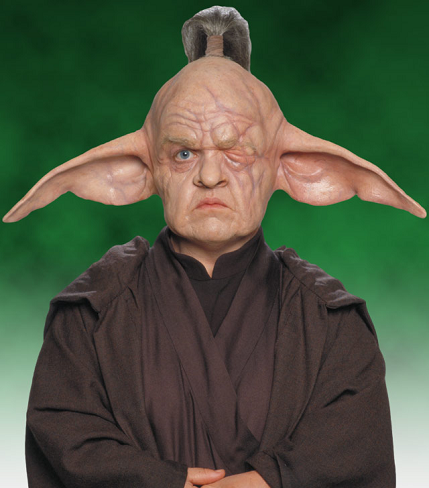
Judging by Piell's topknot, this was probably the approach preferred for use if Sorsha ended up with the "fierce" look of the shaved-head-and-topknot hairstyle drawn by Moebius.
On the other hand, if Sorsha instead had the full head of hair seen in Moebius's alternative drawing of her, she would likely have retained her milky blind eye, as in this ROTJ sketch of Darth Vader unmasked.
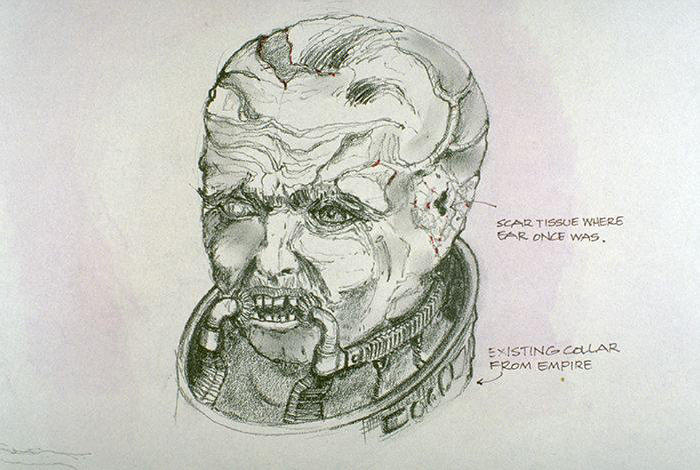
Her damaged eye and long hair would echo the appearance of Mel Gibson in Mad Max Beyond Thunderdome.
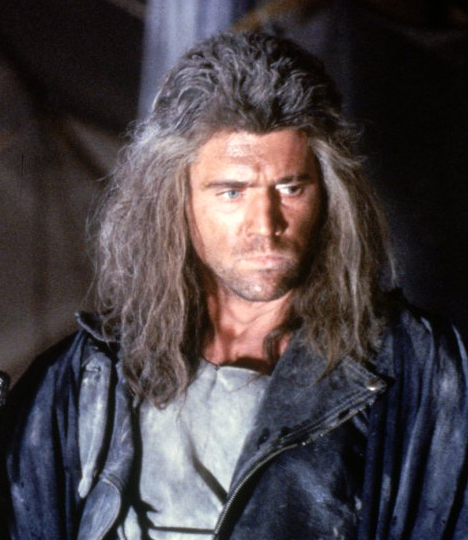
“That Darth Vader, man. Sure does love eating Jedi.”